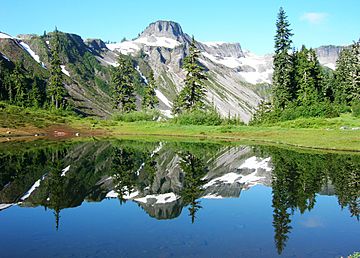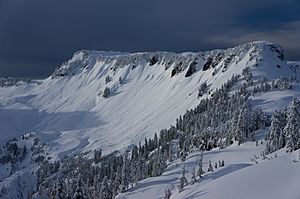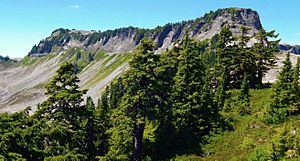Table Mountain (Whatcom County, Washington) facts for kids
Quick facts for kids Table Mountain |
|
|---|---|

Table Mountain seen from Austin Pass
|
|
| Highest point | |
| Elevation | 5,742 ft (1,750 m) |
| Prominence | 422 ft (129 m) |
| Isolation | 0.84 mi (1.35 km) |
| Parent peak | Mazama Dome (5,820 ft) |
| Geography | |
| Location |
|
| Parent range | North Cascades |
| Topo map | USGS Shuksan Arm |
| Geology | |
| Type of rock | Andesite lava |
| Volcanic arc | Cascade Volcanic Arc |
| Climbing | |
| Easiest route | Hiking trail |
Table Mountain is a cool mountain peak in the Skagit Range. It's found in the North Cascades of Washington state. You can find it west of Mount Shuksan and northeast of Mount Baker.
This mountain is part of the Mount Baker Wilderness. The Mount Baker-Snoqualmie National Forest helps manage this area. Table Mountain is west of Artist Point, right at the end of the Mount Baker Highway.
From the Artist Point parking lot, there's a short 1.4-mile trail. This trail leads you right to the top of the mountain. From the summit, you get amazing views! You can see Mount Shuksan, Mount Baker, Mount Hermann, and Mount Larrabee. There are even parts of the Table Mountain Glacier still on its northeast side. Water from the mountain flows into the Skagit and Nooksack Rivers.
Weather and Climate
Table Mountain is in a special weather zone called a marine west coast climate. This is common in western North America. Most of the weather comes from the Pacific Ocean. It travels northeast towards the Cascade Mountains.
As these weather systems hit the North Cascades, the mountains push the air upwards. This is called Orographic lift. When the air rises, it drops its moisture as rain or snow. Because of this, the western side of the North Cascades gets a lot of rain and snow. This is especially true in winter.
Table Mountain is located above the Mt. Baker Ski Area. This ski area once had the most snowfall in one season ever recorded! It got 1,140 inches (95 feet or 29 meters) of snow during the 1998–1999 season.
In winter, it's often cloudy. But in summer, high-pressure systems over the Pacific Ocean bring clear skies. Because of the ocean's influence, the snow here is often wet and heavy. This can lead to a high risk of avalanches.
Mountain Geology
The North Cascades has some very rugged land. You'll see jagged peaks, long ridges, and deep valleys carved by glaciers. These amazing shapes and big changes in height were created by geological events over millions of years. These events also led to the different climates you find in the Cascade Range.
The Cascade Mountains started forming millions of years ago. This was during the late Eocene Epoch. The North American Plate was slowly moving over the Pacific Plate. This caused many volcanic eruptions. Mount Baker, a large stratovolcano, started forming during the Pleistocene period. It is about 6.7 miles (10.8 km) southwest of Table Mountain.
Also, small pieces of the Earth's crust, called terranes, helped create the North Cascades. This happened about 50 million years ago.
During the Pleistocene period, over two million years ago, glaciers moved back and forth many times. They scraped the land and left behind piles of rock. The "U"-shaped river valleys you see today were formed by these glaciers. The mountains' tall peaks and deep valleys were created by the land pushing up (uplift) and breaking apart (faulting), along with the glaciers.
Table Mountain itself is made of andesite lava. This lava flow was so thick that scientists think it filled a canyon. It might have even formed a lava lake! The sides of Table Mountain have cool, wild-looking patterns called columnar joints. This suggests the lava flow might have been held in place by glacial ice as it cooled.





